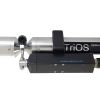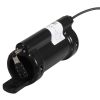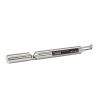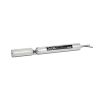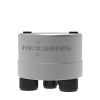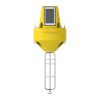TriOS NICO UV Nitrate Sensor
Features
- Internal compensation for temperature, turbidity, and organic substances
- RS-485 Modbus RTU output for integration with data collection platforms
- Optional W55 V2 wiper cleans optics & reduces maintenance intervals
- Expedited repair and warranty service
- Lifetime technical support
- More
Overview
The TriOS NICO is a low-cost UV photometer for online measurement of nitrate in lakes/rivers, drinking water, and wastewater applications. The four detection channels enable a precise optical determination of nitrate by absorption, taking into account turbidity and organic substances that pose a problem for many products currently on the market. An internal temperature correction additionally increases stability of the measured values.
Easy Configuration
The TriOS NICO is compatible with the G2 interface box, allowing fast and easy configuration of the sensors using a web browser. The sensor can be easily integrated into existing process control systems and external data loggers using the native RS-485 Modbus RTU output, and the optional W55 V2 wiper reduces maintenance intervals by cleaning the optics before each measurement.
|
Light Source
|
Xenon flash lamp
|
|
|
Detector
|
4 photo diodes + filter
|
|
|
Measurement principle
|
Attenuation
|
|
|
Optical path
|
0.3mm, 1mm, 2mm, 5mm, 10mm, 20mm, 50mm
|
|
|
|
||
|
Parameter
|
NO3-N, NO3, NOx-N, NOx (calibrated with NO3 standard solution)
|
|
|
Measurement range at 1mm path
|
0.5...60 mg/L NO3-N
|
|
|
Measurement range at 10mm path
|
0.05...6 mg/L NO3-N
|
|
|
Measurement accuracy
|
± (5% + 0.1 mg/L NO3-N) with 10mm path
± (5% + 1 mg/L NO3-N) with 1mm path
|
|
|
Turbidity compensation
|
Yes
|
|
|
Data logger
|
~2 GB
|
|
|
T100 response time
|
20 s
|
|
|
Measurement interval
|
≥ 10 s
|
|
|
|
||
|
Housing material
|
Stainless steel (1.4571/1.4404) or titanium (3.7035)
|
|
|
Dimensions (L x Ø)
|
~ 470 mm x 48 mm (10mm path)
|
~ 18.5“ x 1.9“ (with 10mm path)
|
|
Weight stainless steel
|
~ 3 kg
|
~ 6.6 lbs
|
|
Weight titanium
|
~ 2 kg
|
~ 4.4 lbs
|
|
|
||
|
Interface digital
|
Ethernet (TCP/IP), RS-485 (Modbus RTU)
|
|
|
Power consumption
|
≤ 7 W
|
|
|
Power supply
|
12...24 VDC (±10%)
|
|
|
|
||
|
Maintenance effort
|
≤ 0.5 h/month (typical)
|
|
|
Calibration/maintenance interval
|
24 months
|
|
|
System compatibility
|
Modbus RTU
|
|
|
Warranty
|
1 year (EU: 2 years)
|
US: 2 years
|
|
|
||
|
Max. pressure with SubConn
|
30 bar
|
~ 435 psig
|
|
Max. pressure with fixed cable
|
3 bar
|
~ 43.5 psig
|
|
Max. pressure in FlowCell
|
1 bar, 2...4 L/min
|
~ 14.5 psig at 0.5 to 1.0 gpm
|
|
Protection type
|
IP68
|
NEMA 6P
|
|
|
||
|
Sample temperature
|
+2...+40 °C
|
~ +36 °F to +104 °F
|
|
Ambient temperature
|
+2...+40 °C
|
~ +36 °F to +104 °F
|
|
Storage temperature
|
-20...+80 °C
|
~ -4 °F to +176 °F
|
|
Inflow velocity
|
0,1...10 m/s
|
~ 0.33 to 33 fps
|
In The News
Data in Action: Heidelberg’s Nutrient Monitoring in Great Lakes Tributaries
In the early hours of the morning, when most people have yet to hit snooze for the first time, water sampling sites across Ohio are awake and actively collecting nutrient data. The samplers are active at noon, eight in the evening and four in the morning, but very few people would know or even think about the equipment. Included in those few is Jakob Boehler, field manager for the National Center for Water Quality Research (NCWQR) at Heidelberg University. For Boehler, these systems booting up every day represents valuable data points that will be used to educate the public, influence environmental policies and support future research. “There are 20 of these samplers going off across the state of Ohio and Southeast Michigan.
Read MoreWildfire Prevention in the Sierra Nevada Region with the Yuba Watershed Institute
Though recent wildfires have sparked new conversations about wildfire management and response, groups like the Yuba Watershed Institute have been monitoring the forests and water resources of the Sierra Nevada region for decades, managing approximately 5,000 acres of land with the Bureau of Land Management (BLM) and about 7,000 acres in private land partnerships. The goal of the Institute is to work with local communities and land agencies to improve watershed and forestry management through informed practices and public outreach. The goals of the Yuba Watershed Institute are three-fold: Improve the ability of fire suppression agencies like the California Department of Forestry and Fire Protection ( CAL FIRE ) and the US Forest Service.
Read MoreWave Sensors Integration with NexSens Buoys: A Cutting-Edge Solution for Wave Measurment
Real-time wave data supports accurate weather prediction, safe and efficient maritime operations, and provides valuable safety and operating condition information for recreation and commercial fishing. Understanding wave dynamics also helps with the design of protective coastal structures like seawalls, breakwaters, and jetties. It also supports better prediction of their impact on sediment transport and coastal geomorphology. Wave data is a key factor in qualifying and designing offshore wind farms and harnessing kinetic energy for electrical generation. It helps with the understanding of ocean-atmosphere interactions and contributes to studies of sea-level rise and climate change impacts.
Read More




























